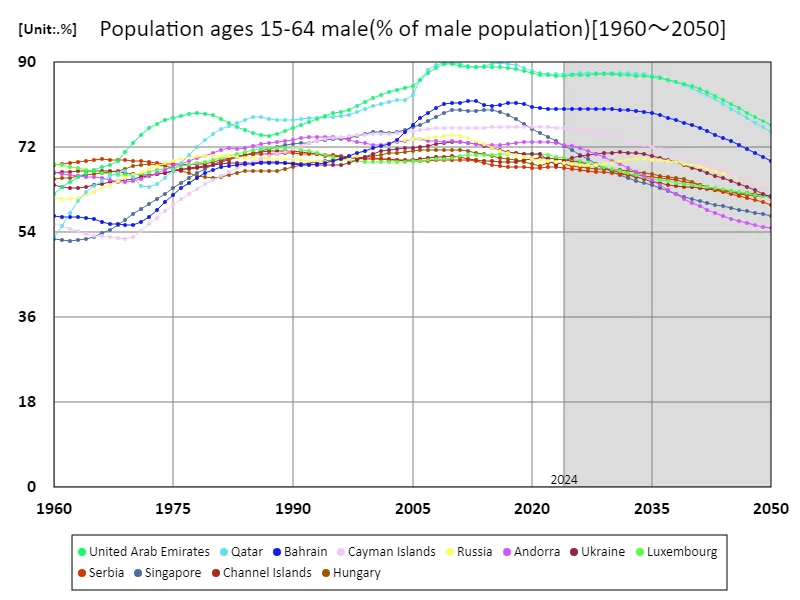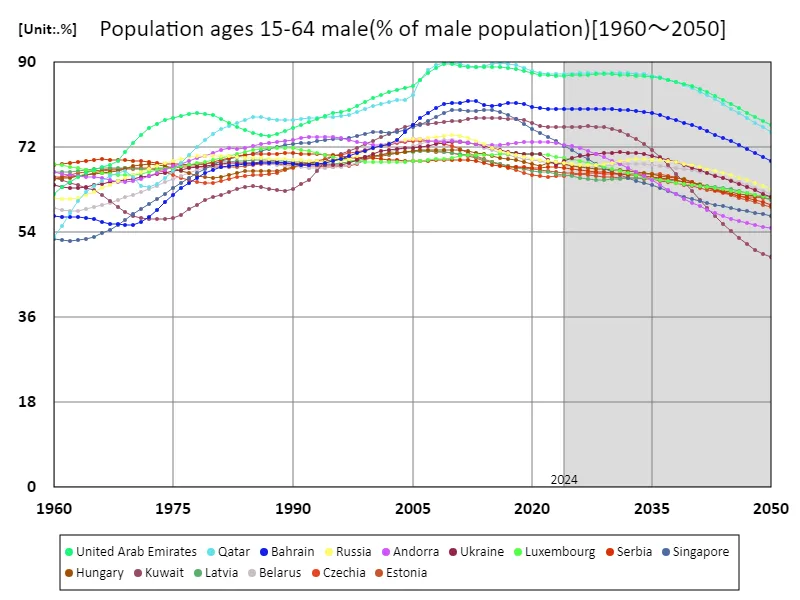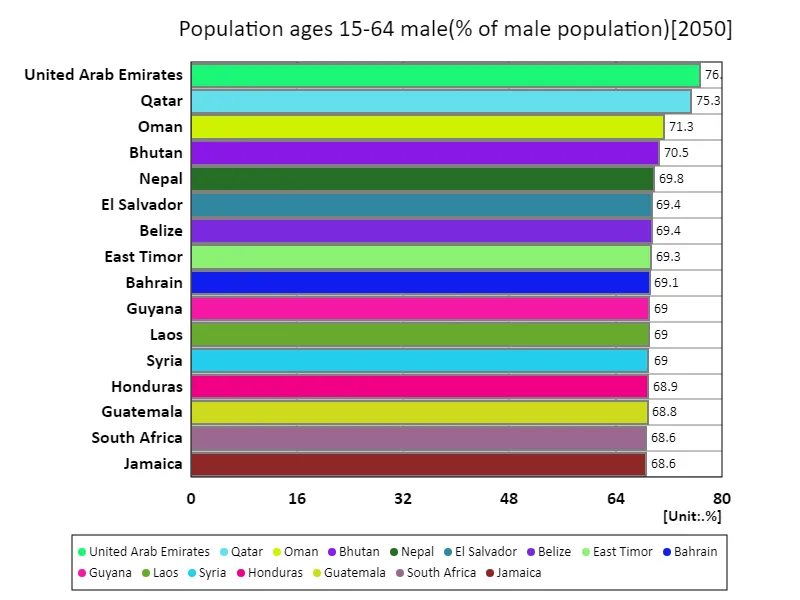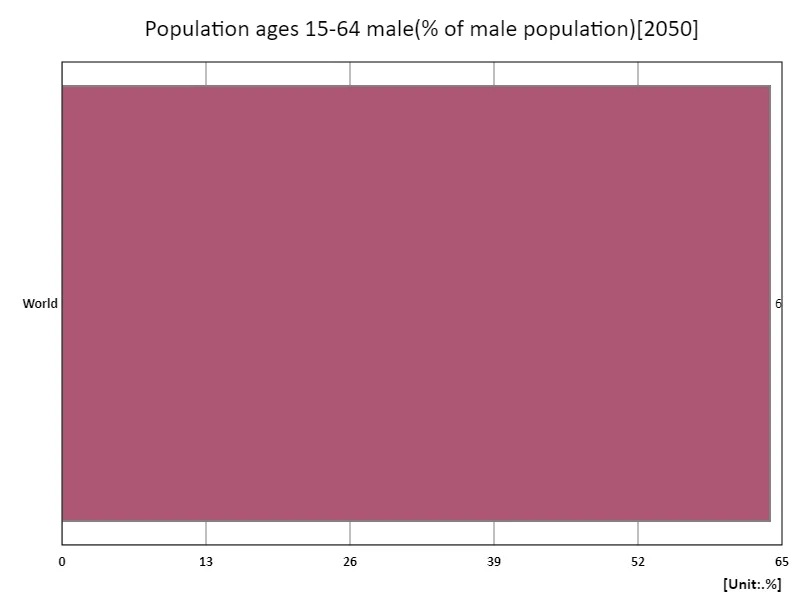Abstract
Countries with a high proportion of males aged 15-64 often have specific economic and social backgrounds. Looking at the United Arab Emirates (UAE) as an example, a high male ratio of 76.7% is predicted in 2050. This high ratio reflects the characteristics of the UAE’s labor market. In the UAE, many foreign workers work in the Middle Eastern construction and oil industries, many of them men. This results in a disproportionate proportion of men in the workforce. Additionally, the skewed gender ratio in the population of these countries can have social and economic consequences. For example, in male-dominated societies, challenges can include changes in family structures and social security systems, and slow female participation in the labor market. On the other hand, a high male ratio can also be a factor in promoting economic growth by providing a temporary source of labor. These trends may be observed in other countries and may have different effects depending on the course of economic development and the structure of the labor market.
Men aged 15-64 (percentage of male population)
As seen in the data on the male population ratio between 15-64 years old in Qatar from 1960 to 2050, the high figures are mainly linked to the country’s rapid economic development. Qatar hit a peak of 90% in 2010, reflecting economic growth fuelled by its abundant oil resources and the resulting influx of a large number of foreign workers. There are many male foreign workers especially in the construction and energy industries, resulting in a disproportionately male ratio. This high male ratio is in response to labour market demand and is closely linked to economic fluctuations. However, the current post-peak figure of 83.7% suggests changes in the economic structure and diversification of the labor market. Qatar’s recent efforts to diversify its economy and promote employment for its citizens have resulted in a decline in the proportion of foreign workers and a more equal gender ratio. This change reflects the country’s strategy to transition to an ageing society and improve social stability, and is likely influenced by long-term economic planning and policies.


The maximum is 90%[2010] of Qatar, and the current value is about 83.7%
Men aged 15-64 (percentage of male population) (Worldwide)
Qatar, which recorded the highest male population ratio in the 15-64 age group in data from 1960 to 2050, had a high ratio of 90% in 2010. This high male ratio is mainly due to the presence of foreign workers who rely on Qatar’s fast-growing energy sector and construction industry. As Qatar’s economy developed rapidly, a large influx of male workers in particular occurred, resulting in a very high overall male ratio. However, since its peak in 2010, the proportion of men in Qatar has fallen to 83.7%. This is a change that is due to the diversification of the country’s economy and the development of higher skilled jobs and service sectors. In addition, the number of foreign workers has decreased and the proportion of domestic workers has increased as a result of the Qatari government’s policy of promoting employment for its nationals and diversifying the economy. This fluctuation reflects economic maturity and social policy developments, and further changes are expected in the future.


The maximum is 90%[2010] of Qatar, and the current value is about 83.7%
Men aged 15-64 (percentage of male population) (Worldwide, latest year)
The United Arab Emirates’ (UAE) male population ratio aged 15-64 is projected to be 76.7% in 2050, reflecting the country’s economic structure and labor market characteristics. In the UAE, many foreign male workers are employed in labor-intensive sectors such as the oil and construction industries. This is the main factor behind the high male ratio. The figures indicate that there is a high demand for male workers as the UAE’s economy grows. The average figure of 63.5% reflects a global trend, with many countries seeing a higher proportion of men in the economic workforce. Male-dominated fields are often associated with heavy labor and technical jobs, and their proportions tend to increase with economic development. The total of 12.5k% is the sum of the overall statistics and represents the cumulative figures for each country. This combines data from individual countries and suggests that overall, men have a higher labour force participation rate. Historically, faster growing economies have seen a higher proportion of men, but as economies mature and labour markets change, we expect to see a more equal gender ratio.


The maximum is 76.7% of United Arab Emirates, the average is 63.5%, and the total is 12.4k%
Men aged 15-64 years (percentage of male population) (region, latest year)
According to data for 2050, South Asia will have the highest male population ratio of 15-64 years old at 67.5%, reflecting the characteristics of the region’s labour market. In South Asia, economic growth and demographic changes have led to higher male labor force participation. This high ratio indicates that men are primarily at the center of economic activity, especially in sectors such as agriculture and manufacturing. The average of 62.7% represents a high proportion of men in the workforce globally and reflects the fact that economically developing countries tend to have male-dominated labour markets. As the population ages, the high male labor force ratio suggests gender imbalances in the labor market and the need for adjustments to social security and pension systems. The total of 940% is a cumulative breakdown of data from each country and indicates higher male labor force participation overall. As a result of past trends, it is expected that as economic development and urbanization progresses, the gender ratio will change and the effects of an ageing population will become apparent, calling for the creation of a more equal labor market.


The maximum is 63.9% of World, the average is 63.9%, and the total is 63.9%



Comments